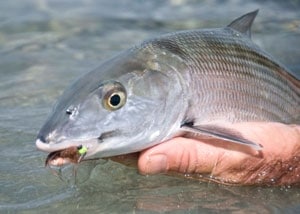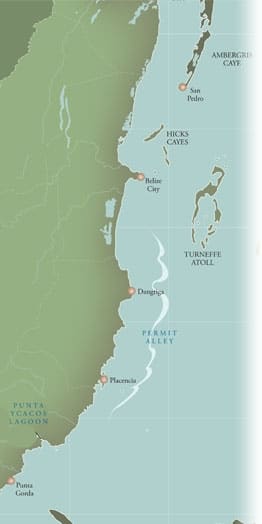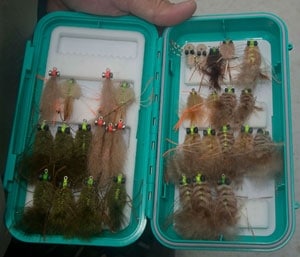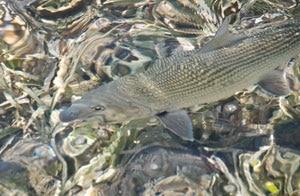
If you had to pick one tropical destination to fish the rest of your days, the little country of Belize would certainly sit high atop anyone’s list. The Caribbean nation has been well chronicled over the years in this magazine – and for good reason.
Belize is a fly-fishing wonderland, replete with some of the world’s most productive waters, which teem with tarpon, bonefish and permit. Productive fishing grounds stretch the entire length of the country, from the northern border with Mexico to the southern line abutting Honduras.
A hotbed of activity over the past decade, Belize has undergone much development, and its vast natural resources have been heavily promoted in recent times. But a disturbing trend emerged: Commercial fishing was on the rise, and it was seeping into the fisheries associated with the country’s flats.
In a bold move to protect these valuable fisheries, the Belizean government proposed legislation that would make any kind of harvest of bonefish, tarpon and permit illegal. And today, after many months of lawmakers ironing out the details, the catch-and-release legislation has been finalized, with enforcement spread among four governmental agencies.
It should prove to be a great thing for Belize and its fish – and it should ensure that visiting fly-anglers can expect excellent fishing for years to come. If you’ve never traveled to this friendly little country, you ought to give it a try. To make your planning a little easier, here’s a rundown of what you can expect throughout the various regions.
Remote Beauty Hallmarks Turneffe
One of Belize’s most unique (and perhaps most famous) regions lies among the turquoise waters around Turneffe Atoll. Turneffe is a large collection of mangrove islands approximately 30 miles long by 12 miles wide which lies directly east of Belize City.
Vast networks of flats, creeks and lagoons pulse throughout the shallow interior of the atoll, while enormous hard-bottomed, wadable flats line its eastern perimeter, bordering the Caribbean. Swimming among all this water are literally thousands of bonefish, tarpon and permit.
Accessible only by boat, Turneffe requires an approximately hour-long ride out of Belize City. When the wind is up and off the sea, the ride can be sporty – but the remote nature of this region adds to the elements of privacy and seclusion, not to mention unspoiled fishing.
“There’s very little development on Turneffe, and it’s probably the most remote of the fisheries in Belize,” says Craig Hayes, owner of Turneffe Flats lodge, one of two fishing resorts located on the atoll. “I remember when I first came here in 1977. It was quite a wild place back then. We opened the lodge in 1981, and it was quite Spartan too!”

That’s not the case anymore. Turneffe Flats sits at the northern end of the atoll, offering its guests comfortable lodging and nine skiffs, with a stable of the area’s best guides. The lodge can accommodate 18 anglers at any given time – but the size of the atoll makes it such that you won’t see many other anglers during a day on the water. When fishing Turneffe, it’s easy to get lost in thoughts among the beauty.
One of the most picturesque areas lies along the atoll’s eastern edge. It’s there that anglers typically chase bonefish over a collection of vast flats, which bridge the mangrove-lined islands and a shallow, wave-lapped reef. It’s a classic setting for flats fishing, and many of the bonefish found here are among the largest anywhere in Belize, a few inching upwards of the 10-pound mark. Schools of hundreds of smaller individuals also gather on these flats. They’re commonly found mudding along the bottom, and they present a prime opportunity for fly-anglers.
Turneffe is home to a terrific permit and tarpon fishery as well. The permit are most often found on mangrove-lined flats within the confines of the atoll, while resident tarpon in the 70- to 90-pound range can be caught on intermediate lines among the creeks and channels of the interior. As with many places in Belize, the tarpon fishing heats up during the summertime, as big 100-plus-pound fish migrate through the waters and eat flies with regularity.
Diversity Abounds at Ambergris
Speaking of big tarpon, perhaps the best place to visit Belize during the annual migration – as well as other times of the year – is bustling Ambergris Caye, in the country’s northern corridor.
The largest island in Belize, Ambergris may be home to some of the most developed waterfront in the country, but the fishing in surrounding waters remains excellent. Like Turneffe Atoll, Ambergris has great diversity. The eastern flats stretching from the mainland to the reef are hard-bottomed and run plentiful with bonefish and permit, while excellent sight-fishing can be had for the various species throughout the fertile waters of Chetumal Bay, on the western side of Ambergris.
“Given just about any weather condition, we can find protection and productive fishing,” says Ali Flota, owner of El Pescador lodge, which opened in 1974 and is one of the premier fly-fishing operations on Ambergris. “Diversity is really our strength.”
Flats in Chetumal, such as those around Blackador Caye, represent classic backcountry permit grounds, while many fine bonefish have been taken over the years by anglers wading and sight-fishing the flats of Cayo Frances. Bacalar Chico National Park and Marine Reserve, which lies to the north and stretches up to the Mexican border, also offers miles of unspoiled opportunity.
Then there are the tarpon.

This area is one of the few locations in Belize that produces sight-casting opportunities for fish on clear, shallow flats similar to those of the Florida Keys. Resident tarpon up to 90 pounds swim these backcountry flats – such as the famed Savannah – throughout the year, while baby tarpon are commonly taken on light fly tackle deep within the mangrove islands of Chetumal.
But from June to mid-September, the big tarpon push in, bringing many dedicated anglers to Ambergris and El Pescador. The fish are usually found in deep channels, such as those around Long Caye and Hicks Caye, and anglers cast to rolling fish with intermediate sinking lines and streamer flies. These tarpon can be extraordinarily big. Two-hundred-pounders have been taken here on conventional gear, and jumping a ‘poon over 150 pounds is not uncommon on fly.
El Pescador is a great destination for families, with 12 rooms in its main lodge and eight three-bedroom villas. The bustling town of San Pedro is nearby, and it is chock-full of lively markets, shopping, open-air bars and excellent restaurants. Try Elvi’s Kitchen, an award-winning local favorite that Elvia Staines started as a takeout window below her home.
Meanwhile, the fly-fishing program at El Pescador ranks as one of the best in Belize. It employs 11 guides on a regular basis and offers free casting seminars every night. It’s a great destination for both experienced fly-anglers and newbies alike.
Belize City to Permit Alley
El Pescador has certainly been around awhile, but a bit south of its waters, in Belize City, lies the country’s first-ever fishing operation, Belize River Lodge. In fact, the latter icon will celebrate its 50th anniversary next year.
Opened in 1960 by Vic Barothy, the lodge resides today on the very same grounds it was founded – those along the Belize River, one of many waterways that empty out of the mountainous inland regions of Belize and into the Caribbean Sea.
One can only imagine what these waters must have been like back in those days. The good news is that the fishing is still fantastic – the lodge’s grounds encompass about 500 square miles and include the extensive Hicks Cayes, Long Cayes and Drowned Caye to the north and southward along the coast to the Manatee River and out to Alligator Caye.
“Our main target species is tarpon, and second would be a combination of permit, bonefish and snook,” says Mike Heusner, who has been at the lodge for 22 years and currently owns it. “We fish those four species every day.”
As with Flota of El Pescador, Heusner is quick to talk about the silver kings of summertime. “When the migratory tarpon move in,” he says, “I don’t think there are many places in the world with better concentrations of fish that stay in the area, as we have here in this region of Belize.”

Heusner also says about 50 to 60 permit are taken annually by his anglers on fly gear, despite the fact that they don’t target the fish exclusively. Indeed, a wonderful permit fishery exists here, and it extends southward along the coast to the region from Dangriga to Placencia, which is famously dubbed Permit Alley.
The first time I visited Permit Alley, fishing out of the village of Hopkins, I was amazed at the number of fish there. After a bumpy 30-minute run by panga from the mainland to the flats, I was casting at tailing permit not five minutes after we came off plane. This went on all morning. For those who have never visited this region, the beautiful, coral-studded blue flats just go on and on. It’s quite a place.
Of course, this region is also home to the famed Blue Horizon Lodge, in Dangriga, and as readers of Fly Fishing in Salt Waters found last issue (“The Permit Whisperer,” September/October 2009), Lincoln Westby knows the fishery as well as anyone. If you don’t mind the rustic nature of Blue Horizon, you’ll certainly be treated to some epic permit action there.
The Wilds of Southern Belize
Permit are abundant along the stretch of coastline known as the Alley, but the farther south one travels in Belize, the more wild, and less populated, it becomes. The geography changes too, with mountainous rainforests extending right up to the coastline.
It’s there that the town of Punta Gorda resides – along with some of the best permit fishing in the world throughout the dynamic and intricate waterways of the Port Honduras Marine Reserve. Honduras is actually visible just across the bay from Punta Gorda on clear days. It’s the end of the road of our southerly travels in Belize.
Permit fishing is all the rage here, and it can be fantastic. Clear-water flats (some of the cleanest I’ve ever seen) surround numerous island chains throughout the bay, with the Punta Ycacos Lagoon lying just to the north.
The lagoon offers a different kind of backcountry permit experience: It’s extreme shallow-water hunting in dirty water riddled with mangrove shoots. At times permit are everywhere in the lagoon. Other times they’re tough to find.
But there’s nothing like stalking them in the blue-water flats outside the lagoon. As with permit fishing most anywhere in Belize, wading is usually preferred, and it’s easily accomplished on these flats. The fish in this region can be very large too.
The famed Garbutt brothers have a new operation in this area and are working through Yellow Dog Fly Fishing Adventures, but for another unique experience, you might consider staying at the Machaca Hill Rainforest Canopy Lodge.
The resort is a one-of-a-kind gem, sitting atop a large hill overlooking the Rio Grande River. Nothing short of five-star, Machaca is completely shrouded in jungle, with howler monkeys calling from the trees. One of the best parts is running down the Rio Grande to the bay. It’s transfixing, as jungle races by you on both sides, and it’s quite common to see rolling tarpon, massive snook or even a crocodile along the way.
But the most exciting moment is when you emerge from the river mouth and see the endless permit flats stretching out in front of you. As you fish these flats, the distant silhouette of a mountainous coast reminds you that you’re truly in a wild place. And the tailing permit you’ll undoubtedly find – it’s common to see dozens any given day – will stay in your memory banks for a long, long time.
Belize is truly a remarkable place. From its northernmost regions around Ambergris Caye to the beauty of Turneffe, down through Permit Alley to the unmolested waters of Punta Gorda, there’s something for everyone. And thanks to the combined efforts of dedicated lodge owners and forward-thinking government officials, it should remain this way for years to come.
Enjoy your next trip.
RODS: Three basic outfits will serve you well throughout most of Belize: a 7- or 8-weight for bonefish, 9- or 10-weight for permit and snook, and an 11- or 12-weight for tarpon.
REELS: High-quality saltwater models built by reputable manufacturers, such as Tibor, Islander and Abel.
LINES: Outfit your smaller rigs with weight-forward floating lines for shallow-water bonefish and permit. Floaters might also work for tarpon on the flats, though intermediate sink tips are probably better. For tarpon in the deeper channels, use an intermediate sink tip or a line that tracks deeper.
LEADERS: Standard 10- to 12-foot tapered varieties ranging from 10- to 16-pound-test tippets, though a 14-foot or longer leader is often helpful for skittish permit. Don’t forget plenty of 60-pound bite-tippet material for tarpon.
FLIES: For bonefish, proven patterns, such as Gotchas, Crazy Charlies, Bonefish Bitters or others, in a variety of colors and weights tied on No. 6 or No. 8 hooks work well. A nice selection of permit crabs, tied in the standard color patterns and weights on No. 2 to 1/0 hooks, are similarly required. For tarpon, any of the classic streamer patterns in proven colors tied on 1/0 to 3/0 hooks should tempt plenty of fish.
OTHER: Wading boots, high-quality polarized glasses and UPF-rated tropical apparel. Also, don’t forget insect repellent and, for tips, an adequate supply of American dollars.
Related Content









